Improving the yield and resistance to external negative factors will help a correctly grafted grape vaccine, which is carried out taking into account the variety of berries. An agrotechnical procedure will help restore or rejuvenate a damaged shrub. Breeders are vaccinated to obtain several varieties of sweet berries on one bush. It is necessary to plant grapes in the case when the summer resident wants to replace the variety that he cultivated earlier. No longer need to plant new seed. The issue can be resolved by vaccination.
Content
Why a plant needs vaccination
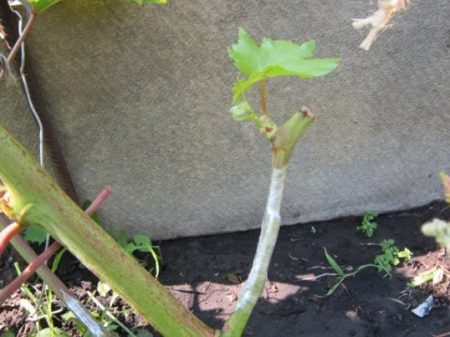 It is scientifically proven that grafted plants are resistant to pests and diseases. Even vigorous grape varieties acquire a compact form. Vaccination is necessary for the vineyard to increase productivity. From a functional point of view, correctly carried out agrotechnical manipulation ensures the growth of the bush in the lower part of the vaccination. The rest of the bush, which is localized above, forms a new variety.
It is scientifically proven that grafted plants are resistant to pests and diseases. Even vigorous grape varieties acquire a compact form. Vaccination is necessary for the vineyard to increase productivity. From a functional point of view, correctly carried out agrotechnical manipulation ensures the growth of the bush in the lower part of the vaccination. The rest of the bush, which is localized above, forms a new variety.
The correct procedure
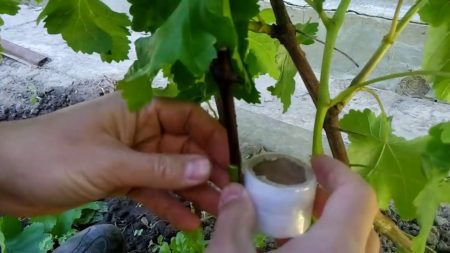 Novice gardeners should not immediately begin vaccination. Start with a workout. For her, they take several unnecessary branches. As soon as the gardener achieves a perfectly even cut, you can proceed to the spring or summer vaccination. Before starting the procedure, botanists recommend removing crooked, thin and damaged cuttings. The likelihood that they will take root is minimal.
Novice gardeners should not immediately begin vaccination. Start with a workout. For her, they take several unnecessary branches. As soon as the gardener achieves a perfectly even cut, you can proceed to the spring or summer vaccination. Before starting the procedure, botanists recommend removing crooked, thin and damaged cuttings. The likelihood that they will take root is minimal.
How to prepare cuttings
The agrotechnical procedure is carried out without taking into account the time factor. Attention is paid only to the ripening speed of the selected variety. Regardless of the duration of the agrotechnical procedure, you need correctly prepare the cuttings:
- take them only from healthy bushes;
- cut the cuttings with a sharp knife;
- the size of the handle, which must be 3 eyes, is: 9-12 cm;
- shoots and foliage are removed from the cuttings.
The lower cut is made oblique, and the upper - straight. Now the summer resident will not mix up where the top is and where the bottom is. Immediately after cutting, the cuttings are dipped in a container with vitriol (3%). The next step is to lay them on a piece of fabric for drying. Vaccination with cuttings will be successful if, after drying, they are wrapped with a damp cloth. Alternatively, polyethylene is allowed. Finished branches are sent to the cellar or refrigerator. They are stored there at a temperature not exceeding + 5C.
Autumn grape grafting
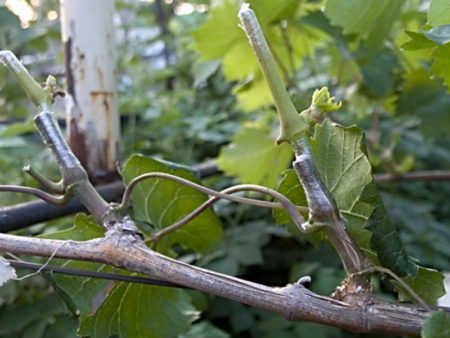 The timing of its implementation is chosen so that the temperature outside the window is not below +15 degrees. For work, take an old bush that will not bear fruit. In order for grape grafting to be successful in the fall, the cuttings are first placed for 72 hours in a container with a growth stimulator. Once the process of kidney swelling is activated on the cuttings, they can be removed from the growth stimulator. The next stage is the accurate cutting of the upper part of the bush, after which the cut point is cleaned using a disinfected knife. The further procedure is as follows:
The timing of its implementation is chosen so that the temperature outside the window is not below +15 degrees. For work, take an old bush that will not bear fruit. In order for grape grafting to be successful in the fall, the cuttings are first placed for 72 hours in a container with a growth stimulator. Once the process of kidney swelling is activated on the cuttings, they can be removed from the growth stimulator. The next stage is the accurate cutting of the upper part of the bush, after which the cut point is cleaned using a disinfected knife. The further procedure is as follows:
- insert a screwdriver into the middle of the stem;
- drive it to a depth of about 3 cm with milk;
- grind the graft on one side until there is a pronounced cone shape;
- cut length limit: 2.5-3 cm;
- insert the handle into the cleft with a sharp end;
- if the size of the splitting allows, then 2 cuttings are grafted onto the old bush;
- to fix the split with a mixture of vines and slightly damp toilet paper;
- the point where the vaccination is performed is often tied with a cotton cloth or twine.
In order for the health of the grafted grafts not to deteriorate, the tissue that wraps the cut area is generously lubricated with garden varieties.
Spring agrotechnical manipulation
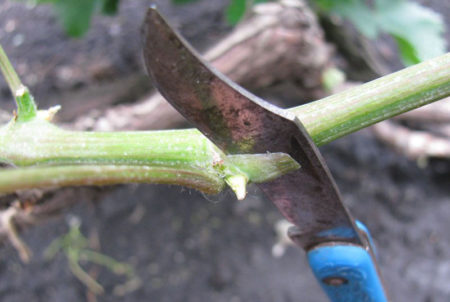 In order for the grape vaccine to pass in the spring without problems, it is carried out after the swelling of the kidneys. The degree of its success depends on how much the gardener is able to choose the right period. In the middle lane Agrotechnical work is carried out in April, as soon as the temperature outside the window stably holds +15 degrees. Spring vaccination will be successful only if the mentioned factor is observed.
In order for the grape vaccine to pass in the spring without problems, it is carried out after the swelling of the kidneys. The degree of its success depends on how much the gardener is able to choose the right period. In the middle lane Agrotechnical work is carried out in April, as soon as the temperature outside the window stably holds +15 degrees. Spring vaccination will be successful only if the mentioned factor is observed.
In temperate regions, vaccinated grapes in spring. Choose the technology of creating splits in the underground trunk. 72 hours before the start of vaccination, cuttings are removed. They are prepared according to the technology described above in the fall. Their tip is carefully sharpened, and then placed in a container in which "Epin" is poured. The trunk, which will become a stock in the future, is dug to a depth of about 20 cm. The base is carefully cleaned of bark. The roots are cut so that they are noticeable.
Once the cleavage is ready, a graft is inserted into it. The next step is to patch up the grafting site with twine. The finishing touch is puttying of the treated area with clay. Practical advice on how to plant grapes will be the recommendation to carefully fill up the hole, after which you need to sprinkle with sand that section of the scion that is located above the ground.
Grape summer vaccination
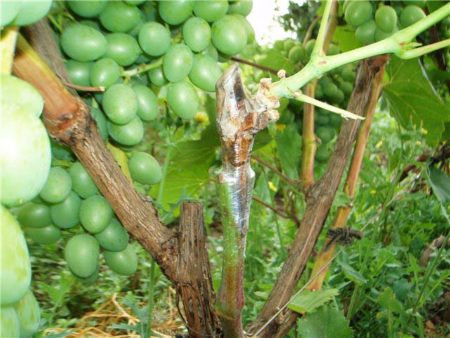 The recommended vaccination time is July and before the beginning of August. Botanists recommend a choice in favor of combined agrotechnical manipulation. First, a cleavage is made, the depth of which is 3-4 cm. A lignified shank is then inserted into it. The further procedure is as follows:
The recommended vaccination time is July and before the beginning of August. Botanists recommend a choice in favor of combined agrotechnical manipulation. First, a cleavage is made, the depth of which is 3-4 cm. A lignified shank is then inserted into it. The further procedure is as follows:
- before planting harvested cuttings, update their slices;
- the location of the cut is just below the kidney;
- both ends are wedge-shaped;
- wedge size: 3 cm;
- as a graft use only those blanks on which the kidneys are present;
- it is forbidden to vaccinate during the heat;
- the optimal period for vaccination is evening or morning;
- for the manipulation take only a healthy vine;
- about 1/3 of the vine is cut off;
- exactly in the middle make an incision of about 3 cm, into which the stalk is inserted;
- the eyes of the stock and scion should not look one way.
The vaccination site is carefully wrapped with a slightly damp cloth. The final stage - the processing site is closed with a plastic bag.
Winter agrotechnical manipulation
Unlike the summer vaccination method, 2-year-old plants are taken in winter. The technique for preparing cuttings is no different from that described above. As soon as the bush loses all leaves, it is cut to 10 cm. The aboveground part is subject to disinfection using 2-3% potassium permanganate. The further procedure is as follows:
- stock is put in a container with sand or sawdust;
- store the capacity in the basement at t about 0C;
- the stock is removed from the basement 24 hours before vaccination;
- it is cleaned and rotten branches are removed from it;
- the length of healthy roots is shortened to 15 cm;
- further storage takes place at t + 20С;
- the stock is put in a container with water for 24 hours, the temperature of which is + 15C;
- as soon as the specified time period is completed, the stock is removed and wiped;
- the stem is grafted to the stock;
- grafted plants are placed in a glass jar and covered with polyethylene;
- the capacity is put in a warm place where the temperature is + 25 + 28C.
After a day, the plant is transferred to a container and placed in a dark and slightly cool place. Grafted plants are removed from the container in the spring, when t outside the window will be stable at + 15C. Before as plant it in open ground, dead parts are removed from the stock.
Green to Green Vaccination
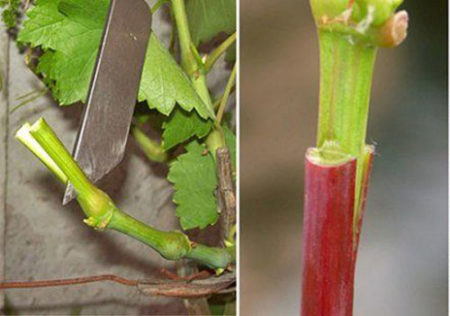 They take an old vine, on which they leave 2 strong sprouts, and the rest are removed. To plant grapes on the old layer is a little easier from a functional point of view. Under the second node make the most straight cut. A leaf that is localized under 1 node can be left on the condition that the stepson does not appear in it. The further procedure is as follows:
They take an old vine, on which they leave 2 strong sprouts, and the rest are removed. To plant grapes on the old layer is a little easier from a functional point of view. Under the second node make the most straight cut. A leaf that is localized under 1 node can be left on the condition that the stepson does not appear in it. The further procedure is as follows:
- the stalk is cut into several blanks, each length will be 4 cm;
- grafting of green to green grapes is carried out so that about 1.5 of its length remains above the leaf, and about 2 cm under it;
- the green leaf is cut to ½ of its size;
- the second cut of the scion, which is located below, is carried out in a wedge-shaped form;
- as soon as both elements are connected, the place of vaccination is isolated with film and garden var.
The blank is placed in a plastic bottle. As soon as the growth of a new branch is noticeable, you can remove the previously applied film.
The use of one-eyed cuttings
The technique is referred to as one of the varieties of summer vaccination. If everything is done correctly, then the summer resident will be able to speed up the time of harvesting several times than using the “green” to “green” technology. The functional difference between the two methods is the time of harvesting the scion. When using 1-eye cuttings, work begins in the fall. During winter storage, the summer resident monitors the temperature background. If the cuttings do not dry, then agricultural manipulation will be successful. A practical video will tell you that after the onset of stable autumn heat, an inspection of the cuttings is carried out. Only the healthiest ones are taken, which are carefully placed for 48 hours in a container of water. 100 g of Kornevin are bred in it. Subsequently, the following procedure is followed:
- the branches are dried;
- cut into small pieces so that each had only 1 peephole;
- the edge of each slice is sealed with paraffin;
- cuttings are stored until the beginning of June at t +4 + 6C in separate cellophane bags;
- with the onset of summer, the scion is removed from the refrigerator;
- a wedge-shaped incision is made on their lower part;
- insert the scion into the cleft of a young branch.
In the future, they adhere to the order of actions that is characteristic of the technology “green” to “green”.
Proper care
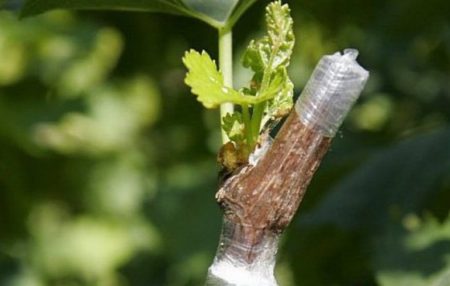 Inoculated bushes are regularly looked after. Every 4-5 days, the soil in the area of the trunk circle is loosened and spud to increase the depth to which oxygen penetrates, top dressing and water. Before making this or that decision, the gardener evaluates the condition of the bush:
Inoculated bushes are regularly looked after. Every 4-5 days, the soil in the area of the trunk circle is loosened and spud to increase the depth to which oxygen penetrates, top dressing and water. Before making this or that decision, the gardener evaluates the condition of the bush:
- Digging is carried out after 14 days from the moment when the summer resident saw that no shoots had formed on the grafted cuttings.
- The upper part of the stock is removed together with the previously vaccinated, after which re-vaccination is carried out.
- Botanists recommend regularly monitoring how well stock and scion grow together. The check is carried out at least 1 time every 12 days. If there are roots that are not part of the stock, then they are removed.
- Weed removal is carried out regularly.If weather forecasters promise a sharp cooling, then fir spruce branches are used as a warming element.
Every 3 weeks carry out processing shrubs from fungus. Any solution that is purchased at a gardening goods store will do.
Common mistakes
Wrong storage of cuttings - A common reason why grafting in the summer or fall fails. The recommended temperature background is about 5 degrees. Exceeding or lowering the temperature will lead to a rapid loss of moisture from the cuttings. The second common mistake is the use of scion and rootstock with different ripening dates. The list of gardener's flaws concludes with an inadequate treatment of the splitting site. It forms rot.
Reviews
Valentine
She was vaccinated in the summer. I wanted to get several varieties of berries on one bush. Took rootstocks with several green leaves. Unfortunately, the experience was unsuccessful. The large jumps in summer and autumn temperatures did the trick.
Peter
I am vaccinating with stock, on which there are already or not yet “awakened” shoots. The place of the procedure is located at a distance of about 40 cm from the soil. Then I take an interval equal to 2-3 kidneys. The optimal time is June 20 - July 20. In the middle lane, other dates are impractical.
Vaccination of grape crops is necessary to increase immunity and yield of green spaces. Spend it at any time of the year, taking into account the characteristics of the selected variety. The secret to success is a perfectly even cut and storage of workpieces in a cool place.




 Non-covering winter-hardy grape varieties for Moscow region
Non-covering winter-hardy grape varieties for Moscow region How to keep the vine in winter
How to keep the vine in winter When can I transfer grapes to another place in the fall
When can I transfer grapes to another place in the fall How to cover and prepare grapes for the winter in the suburbs
How to cover and prepare grapes for the winter in the suburbs